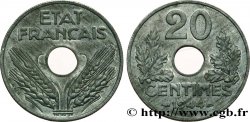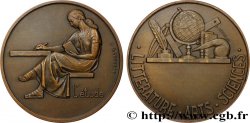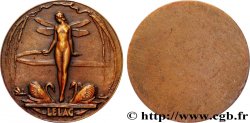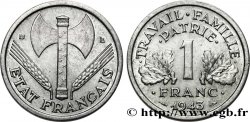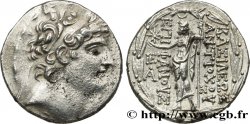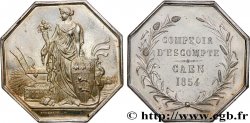Live auction - fmd_679066 - Pré-série sans le mot ESSAI de 20 centimes État français, légère, poids léger (2,88 g) 1943 F.153A/1 var.
Sie müssen angeschlossen sein und von cgb.fr genehmigt werden, um in einer E-Auktion teilzunehmen.Melden Sie sich an, um zu wetten..Die Kontobestätigungen sind innerhalb von 48 Stunden nach Ihrer Anmeldung gemacht.Warten Sie nicht bis die letzten zwei Tage vor dem Abschluss eines Verkaufs, um Ihre Registrierung abzuschließen. Klickend "BIETEN" verpflichten Sie sich vertraglich, diesen Artikel zu kaufen und Sie nehmen ohne Reserve die allgemeinen Verkaufsbedingungen für den live auctions zu cgb.fr an.
Der Verkauf wird an der Zeit auf der Übersichtsseite angezeigt geschlossen werden. Angebote, die nach der Schließung Zeit empfangen sind, werden nicht gültig.
Bitte beachten Sie, dass die Fristen für die Einreichung Ihres Angebots auf unsere Server können variieren und es kann zur Ablehnung Ihres Angebots entstehen, wenn es in den letzten Sekunden des Verkaufs gesendet wird. Die Angebote sollen mit ganzer Zahl ausgeführt sein, Sie können Kommas oder des Punktes in Ihrem Angebot nicht erfassen. Bei Fragen klicken Sie hier, um einen Blick auf die FAQ Live-Auktionen.
Alle Gewinngebote unterliegen einem Aufschlag von 18 % für Verkaufskosten.
Alle Gewinngebote unterliegen einem Aufschlag von 18 % für Verkaufskosten.
| Schätzung : | 200 € |
| Preis : | 116 € |
| Höchstgebot : | 200 € |
| Verkaufsende : | 05 September 2023 18:53:21 |
| Bieter : | 3 Bieter |
Type : Pré-série sans le mot ESSAI de 20 centimes État français, légère, poids léger (2,88 g)
Datum: 1943
Prägemenge : ---
Metall : Zink
Durchmesser : 24 mm
Stempelstellung : 6 h.
Gewicht : 2,88 g.
Rand cannelures fines
Seltenheitsgrad : R3
Slab

NGC : MS63
Kommentare zum Erhaltungszustand:
Sous coque NGC MS63, Thin Planchet
N° im Nachschlagewerk :
Pedigree :
Cet exemplaire provient de la Collection Michel
Vorderseite
Titulatur der Vorderseite ETAT FRANÇAIS.
Beschreibung Vorderseite Au-dessus d'épis posés sur un cartouche ; trou de perforation.
Rückseite
Titulatur der Rückseite 20/ CENTIMES/ 1943.
Beschreibung Rückseite Entre deux branches de chêne.
Kommentare
Toutes les 20 centimes État français contenues dans la Collection Michel ont pour point commun d’avoir une masse comprise aux alentours de 2.80 g. Par un effet du hasard (qui n'en est pas un) les exemplaires de la Collection PIERRE se situent à 3 g comme par exemple pour l'exemplaire suivant : https://www.cgb.fr/20-centimes-etat-francais-frappe-courante-1943-paris-f-153a-1-spl,v30_1159,a.html.
L'explication concernant les exemplaires de 2,8 g et de 3 g se trouve dans les archives de La Monnaie de Paris et à la page 832 de l'ouvrage “LE FRANC LES MONNAIES, LES ARCHIVES 2019” de Philippe Théret, le PV associé du 19 JUIN 1943 si situant en bas de page. L'alliage utilisé pour la réalisation des frappes est un zinc alu et il est précisé que les coins courants ont été utilisés (absence du mot essai). Les frappes ont donc été réalisées les 19 et 22 Juin 1943 sous la forme d'essais industriels (définition exacte d'une pré-série) sans le mot essai.
Le tirage réel est indiqué sur le PV:
- 3 g : 19 502 unités
- 2,8 g : 21 363 unités
Le modèle de 2,8 g n'ayant pas été retenu, l'ensemble du tirage a été cisaillé sauf 40 exemplaires et par conséquent un indice de rareté R3 est bien mérité pour l'ensemble des survivants. Le modèle de 3 g est donc de fait plus commun, la pré-série impossible à identifier par rapport au tirage normal qui a suivi.
Il est à noter que l'exemplaire actuellement en vente est lourd (2,88 g) pour un modèle 2,8 g mais la tolérance est large pour ce type (plus ou moins 5%) ce qui donne un modèle très léger jusqu'à 2,94 g. Le modèle léger de 3 g peut descendre jusqu'à 2,85 g. Ainsi le doute peut être permis pour cet exemplaire mais l'appartenance à la collection MICHEL peut permettre de le lever.
All the 20 centime French State coins contained in the Michel Collection have in common a mass of around 2. 80 g. By chance (which is not one) the examples of the PIERRE Collection are at 3 g as for example for the following example: https://www. cgb. fr/20-centimes-state-french-current-minted-1943-paris-f-153a-1-spl,v30_1159,a. html.
The explanation concerning the 2.8 g and 3 g examples can be found in the archives of La Monnaie de Paris and on page 832 of the work “LE FRANC LES MONNAIES, LES ARCHIVES 2019” by Philippe Théret, the associated PV of June 19, 1943 is located at the bottom of the page. The alloy used for the production of the strikes is zinc aluminum and it is specified that the standard dies were used (absence of the word test). The strikes were therefore carried out on June 19 and 22, 1943 in the form of industrial tests (exact definition of a pre-series) without the word test.
The actual mintage is indicated on the PV: - 3 g: 19,502 units - 2.8 g: 21,363 units The 2.8 g model not having been retained, the entire mintage was sheared except for 40 examples and consequently a rarity index R3 is well deserved for all the survivors. The 3g model is therefore in fact more common, the pre-series impossible to identify compared to the normal print run that followed.
It should be noted that the example currently on sale is heavy (2.88 g) for a 2.8 g model but the tolerance is wide for this type (plus or minus 5%) which gives a very light model up to 2.94 g. The lightweight 3g model can drop down to 2.85g. So doubt may be allowed for this example but the fact that it belongs to the MICHEL collection can help to remove it.
L'explication concernant les exemplaires de 2,8 g et de 3 g se trouve dans les archives de La Monnaie de Paris et à la page 832 de l'ouvrage “LE FRANC LES MONNAIES, LES ARCHIVES 2019” de Philippe Théret, le PV associé du 19 JUIN 1943 si situant en bas de page. L'alliage utilisé pour la réalisation des frappes est un zinc alu et il est précisé que les coins courants ont été utilisés (absence du mot essai). Les frappes ont donc été réalisées les 19 et 22 Juin 1943 sous la forme d'essais industriels (définition exacte d'une pré-série) sans le mot essai.
Le tirage réel est indiqué sur le PV:
- 3 g : 19 502 unités
- 2,8 g : 21 363 unités
Le modèle de 2,8 g n'ayant pas été retenu, l'ensemble du tirage a été cisaillé sauf 40 exemplaires et par conséquent un indice de rareté R3 est bien mérité pour l'ensemble des survivants. Le modèle de 3 g est donc de fait plus commun, la pré-série impossible à identifier par rapport au tirage normal qui a suivi.
Il est à noter que l'exemplaire actuellement en vente est lourd (2,88 g) pour un modèle 2,8 g mais la tolérance est large pour ce type (plus ou moins 5%) ce qui donne un modèle très léger jusqu'à 2,94 g. Le modèle léger de 3 g peut descendre jusqu'à 2,85 g. Ainsi le doute peut être permis pour cet exemplaire mais l'appartenance à la collection MICHEL peut permettre de le lever.
All the 20 centime French State coins contained in the Michel Collection have in common a mass of around 2. 80 g. By chance (which is not one) the examples of the PIERRE Collection are at 3 g as for example for the following example: https://www. cgb. fr/20-centimes-state-french-current-minted-1943-paris-f-153a-1-spl,v30_1159,a. html.
The explanation concerning the 2.8 g and 3 g examples can be found in the archives of La Monnaie de Paris and on page 832 of the work “LE FRANC LES MONNAIES, LES ARCHIVES 2019” by Philippe Théret, the associated PV of June 19, 1943 is located at the bottom of the page. The alloy used for the production of the strikes is zinc aluminum and it is specified that the standard dies were used (absence of the word test). The strikes were therefore carried out on June 19 and 22, 1943 in the form of industrial tests (exact definition of a pre-series) without the word test.
The actual mintage is indicated on the PV: - 3 g: 19,502 units - 2.8 g: 21,363 units The 2.8 g model not having been retained, the entire mintage was sheared except for 40 examples and consequently a rarity index R3 is well deserved for all the survivors. The 3g model is therefore in fact more common, the pre-series impossible to identify compared to the normal print run that followed.
It should be noted that the example currently on sale is heavy (2.88 g) for a 2.8 g model but the tolerance is wide for this type (plus or minus 5%) which gives a very light model up to 2.94 g. The lightweight 3g model can drop down to 2.85g. So doubt may be allowed for this example but the fact that it belongs to the MICHEL collection can help to remove it.







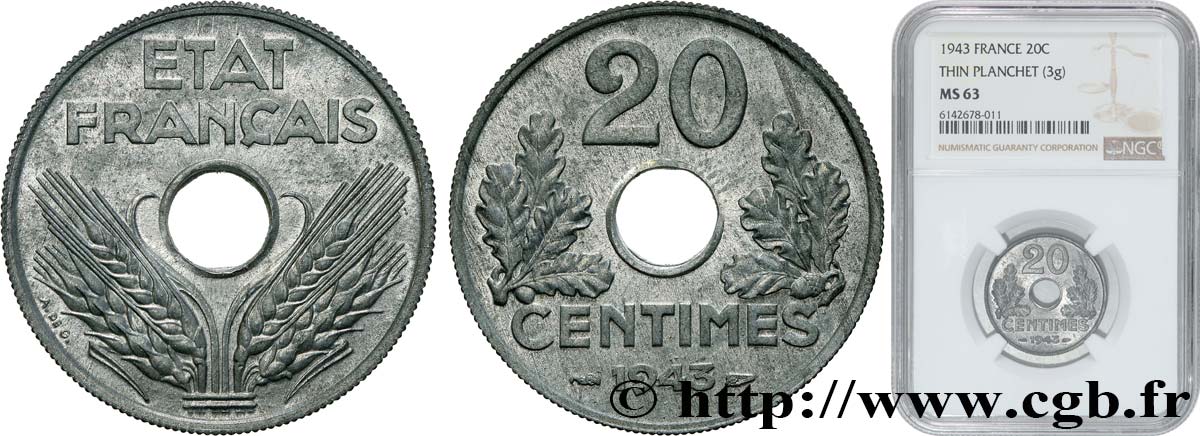
 Berichten über einen Fehler
Berichten über einen Fehler Die Seite drucken
Die Seite drucken Teilen meiner Auswahl
Teilen meiner Auswahl Stellen Sie eine Frage
Stellen Sie eine Frage Einlieferung/Verkauf
Einlieferung/Verkauf
 Details
Details